Pete Shelley’s departure from Buzzcocks felt abrupt. When he left the Manchester band which had been integral to British punk since 1976, the other members thought it was still a going concern. Shelley had reached a different conclusion.
Buzzcocks played what turned out the be their final show on 23 January 1981. At this point, making a new album, their fourth, was on the table. Neither the band or the audience in Hamburg knew it was the last time the band would be seen on stage. A little over a month later, on 4 March, Shelley put his name to a letter dissolving the band. “Homosapien,” his first solo single, was released on 11 September 1981.
 There were business problems. Buzzcocks' last album, A Different Kind Of Tension, was issued in September 1979. Three singles released in 1980 weren’t strong sellers. Their label Liberty wasn’t interested and turned off the money tap. Their music publishers Virgin did the same. A couple of days into January 1981, during sessions for that proposed fourth album, producer Martin Rushent – who had worked with Buzzcocks since 1977 – suggested putting things on hold until the finances were sorted out. It seemed that time might be up for Buzzcocks.
There were business problems. Buzzcocks' last album, A Different Kind Of Tension, was issued in September 1979. Three singles released in 1980 weren’t strong sellers. Their label Liberty wasn’t interested and turned off the money tap. Their music publishers Virgin did the same. A couple of days into January 1981, during sessions for that proposed fourth album, producer Martin Rushent – who had worked with Buzzcocks since 1977 – suggested putting things on hold until the finances were sorted out. It seemed that time might be up for Buzzcocks.
Rushent had his own studio and, on 13 February, Shelley went in to record demos of songs intended for the proposed Buzzcocks album. However, once he heard the results – Rushent had added rhythm tracks and synths to Shelley’s acoustic guitar and voice – Rushent told Shelley he thought what had been recorded sounded finished, as if it could be issued. The 4 March letter duly followed. Time was up for Buzzcocks.
Speaking to the music weekly Sounds in January 1982, Shelley circuitously, somewhat evasively, explained his reasons for the split. "I left the Buzzcocks because I found a way of doing what I wanted which short circuited all the problems I'd had in the past. It was hard to get the idea that I had across. I'm not very good at communicating ideas, all the ones I have I tend to put into music,” he said. "I don't have the vocabulary to put ideas across to individual people at individual times. There was no way that I knew of to change the Buzzcocks so my ideas could get over. I managed to display my finest feelings in almost avant-garde form and no one, well, a few people, understood. Towards the end I wasn't doing myself any good. I was just wringing out my soul to get songs done."
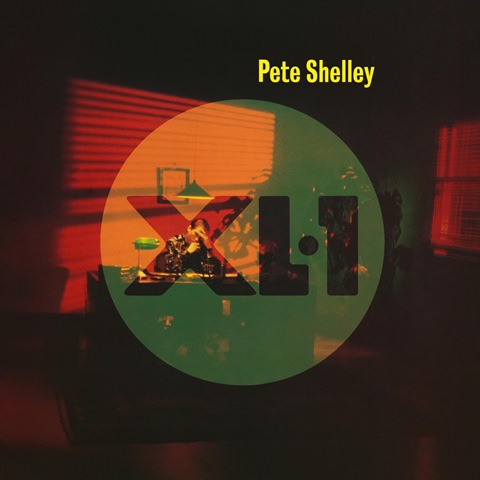 Solo it was then. First single “Homosapien” was swiftly followed in October 1981 by a second, “I Don't Know What it is.” The Homosapien album hit shops in January 1982. As a single, “Homosapien” was remarketed in May 1982 with a different B-side. There was momentum: second solo album XL-1 was released in May 1983. The Homosapien and XL-1 albums are now reissued, each supplemented by non-album tracks from singles and the dub mixes originally issued on the cassette version of the latter album and a promo-only 12-inch.
Solo it was then. First single “Homosapien” was swiftly followed in October 1981 by a second, “I Don't Know What it is.” The Homosapien album hit shops in January 1982. As a single, “Homosapien” was remarketed in May 1982 with a different B-side. There was momentum: second solo album XL-1 was released in May 1983. The Homosapien and XL-1 albums are now reissued, each supplemented by non-album tracks from singles and the dub mixes originally issued on the cassette version of the latter album and a promo-only 12-inch.
Of the two albums, Homosapien is the stronger, with more up-front songs and an interesting contrast between positivity and uncertainty. It opens with the immediate, powerful title track and then speedily gets into questions of what is or isn’t reality with “Yesterday’s Not Here.” “Qu'est-ce Que C'est Que Ça,” “I Don't Know What it is” and album closer “It's Hard Enough Knowing” similarly address ambivalence. On Side One, the hard-edged “I Generate a Feeling” points to XL-1’s relative toughness. The more brittle XL-1 feels as if it was more of an effort to make, and Shelley doesn’t sound fully engaged. Both albums are great, but the second is the lesser of the two. Neither, however, despite their synth-pop slant sound (or sounded) at one with the just-emerging new pop and its shininess: The Human League, Duran Duran, etc. Shelley hadn’t fully shaved the edges of his punk angularity.
On the face of it though, Homosapien and XL-1 drew a line between Shelley and the punk era which spawned Buzzcocks. The sleeves said as much. Each cover photo shows him in a corporate setting: wearing a suit in what looks like a board room for Homosapien and behind a desk for XL-1.
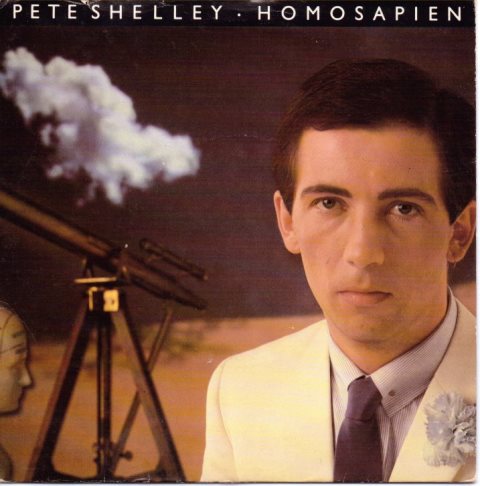 Yet despite this and the seeming suddenness of Pete Shelley’s metamorphosis from Buzzcocks lynchpin to solo artist with synth-pop inclinations, there were odd associations between the new now and what had sharply become then. The arrangement and structure of Buzzcocks’ July 1979 B-side “Something's Gone Wrong Again” was very similar to that of “Homosapien.” On A Different Kind Of Tension, Shelley is credited with “atmospheric keyboards.” Sky Yen, an album of Shelley’s 1974 pre-Buzzcocks recordings made with an oscillator had been released in April 1980. The boundaries of Buzzcocks were becoming elastic. (pictured right, the "Homosapien" single)
Yet despite this and the seeming suddenness of Pete Shelley’s metamorphosis from Buzzcocks lynchpin to solo artist with synth-pop inclinations, there were odd associations between the new now and what had sharply become then. The arrangement and structure of Buzzcocks’ July 1979 B-side “Something's Gone Wrong Again” was very similar to that of “Homosapien.” On A Different Kind Of Tension, Shelley is credited with “atmospheric keyboards.” Sky Yen, an album of Shelley’s 1974 pre-Buzzcocks recordings made with an oscillator had been released in April 1980. The boundaries of Buzzcocks were becoming elastic. (pictured right, the "Homosapien" single)
Other connections only became clear after Homosapien was out, when Shelley revealed that some of the newly issued songs were actually written before Buzzcocks formed, and had been in the repertoire of his 1974 band Jets Of Air. Homosapien’s title track, “Pusher Man” and the contemporaneous B-side “In Love With Somebody Else” drew from this well, as did XL-1’s "Telephone Operator" and “What Was Heaven?”
There was more. The solo Shelley was surrounded with figures familiar from his recent Buzzcocks past. Once Liberty had passed on the newly solo Shelley, Rushent – now his manager – contacted former United Artists A&R man Andrew Lauder (UA had been bought out by Liberty) who was now working for Island Records. He took Shelley on, just as he had with Buzzcocks for UA in 1977. A deal made between Island and Rushent’s Genetic concern (which'd had its office in the same Holborn building as Lauder when he was with his immediately post-UA label Radar Records).
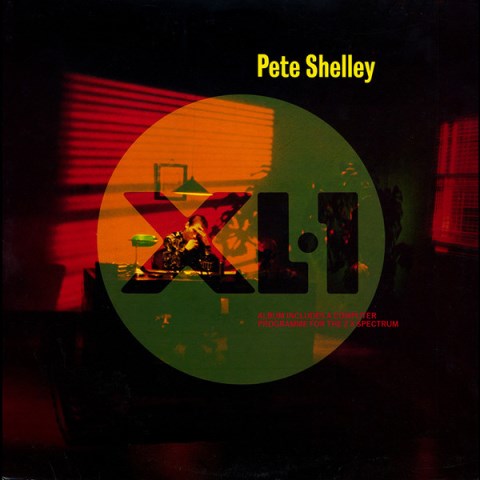 Although Shelley was not stepping into an unknown world when he decided to go solo, his chances of a UK hit with his debut single diminished when the BBC decided not to play “Homosapien.” In January 1982, he told Sounds that “the BBC thought it was a gay song [which] is great, fantastic. I'm a sexual person, I don't bother delineating myself into homo, hetero or bi, it just depends on the person, the situation and what happens.” (pictured left, the original sleeve of the XL-1 LP)
Although Shelley was not stepping into an unknown world when he decided to go solo, his chances of a UK hit with his debut single diminished when the BBC decided not to play “Homosapien.” In January 1982, he told Sounds that “the BBC thought it was a gay song [which] is great, fantastic. I'm a sexual person, I don't bother delineating myself into homo, hetero or bi, it just depends on the person, the situation and what happens.” (pictured left, the original sleeve of the XL-1 LP)
Another potential stumbling block arrived with the increasing commercial success of another of Rushent’s clients, The Human League. Inevitably, Rushent’s profile rose alongside that of The Human League. Shelley was not pulled along in the slipstream. Still, he assembled a live band with bassist Barry Adamson, formerly of original Buzzcock Howard Devoto’s band Magazine, and began playing live in March 1982. A reconfigured version of Homosapien was issued in the US, and dates were played there in May. There was college radio play. No problems with lyrical subject matter.
XL-1 came next. It featured Barry Adamson and drummer Jim Russell from the live band, as well as a musician credit for Rushent. Embedded in its grooves was a computer programme: record it onto cassette, feed it into a home computer and moving graphics and the album’s lyrics could run in sync on a screen with each side of the album (this coding is not included on the new reissue, and the front of the sleeve has been amended to remove the words ‘album includes a computer programme for the Z X Spectrum’ which were on the original cover).
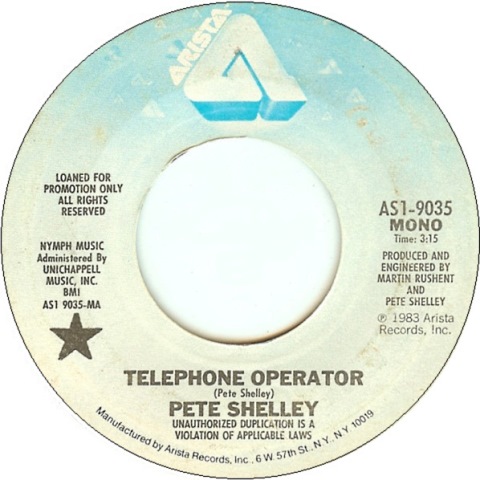 By the time XL-1 was out, Lauder had left Island and, as it had been with the late-stage Buzzcocks, no one at Shelley’s label was interested in him. History was repeating. April 1983’s “(Millions of People) No One Like You” single was the final release through the Genetic/Island deal. In the US, Arista persisted a little longer with a June 1983 single of “Telephone Operator,” (pictured right) but that was the last gasp of the immediately post-Buzzcocks solo Pete Shelley. All very strange considering that “Homosapien” had gone Top Ten on the Australian and Canadian charts, and that most of Shelley’s US singles sold strongly enough to get onto the dance charts. In the US, Arista were rather wonderfully promoting him as “blending Sixties pop melodies with disco staples to forge a rock hybrid for the Eighties.” But by late summer 1982 it was over.
By the time XL-1 was out, Lauder had left Island and, as it had been with the late-stage Buzzcocks, no one at Shelley’s label was interested in him. History was repeating. April 1983’s “(Millions of People) No One Like You” single was the final release through the Genetic/Island deal. In the US, Arista persisted a little longer with a June 1983 single of “Telephone Operator,” (pictured right) but that was the last gasp of the immediately post-Buzzcocks solo Pete Shelley. All very strange considering that “Homosapien” had gone Top Ten on the Australian and Canadian charts, and that most of Shelley’s US singles sold strongly enough to get onto the dance charts. In the US, Arista were rather wonderfully promoting him as “blending Sixties pop melodies with disco staples to forge a rock hybrid for the Eighties.” But by late summer 1982 it was over.
Of course, he continued making records. Buzzcocks reformed in 1989. But, whatever the fantastic records they generated, the 1981 to 1983 solo years remain intriguing. The choice to go solo was made passively, in response to random circumstance rather than as the result of a plan.
Once this path was chosen Shelley pursued it with vigour, drawing on everything he had to hand: songs from before Buzzcocks, his old band’s producer, the music biz figure who had signed them, the bassist from Magazine. It all ought to have come together as neatly as a successfully devised boardroom plan. Pete Shelley could have been a UK chart regular in the Homosapien and XL-1 period. But this is not how things turned out.
- Next week: Gather In The Mushrooms - documenting what was dubbed "acid folk"
- More reissue reviews on theartsdesk
- Kieron Tyler’s website

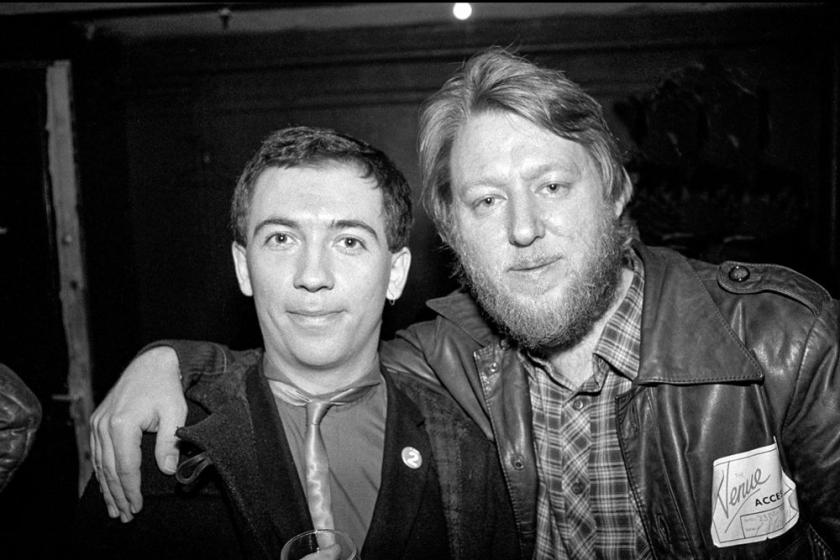












Add comment